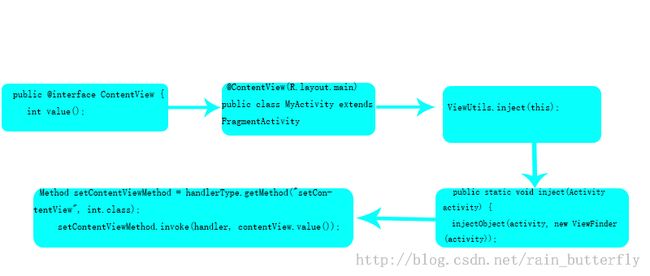Android 最火的快速开发框架XUtils
比较了一下XUtils是目前git上比较活跃 功能比较完善的一个框架,是基于afinal开发的,比afinal稳定性提高了不少,下面是介绍:
xUtils简介
- xUtils 包含了很多实用的android工具。
- xUtils 最初源于Afinal框架,进行了大量重构,使得xUtils支持大文件上传,更全面的http请求协议支持(10种谓词),拥有更加灵活的ORM,更多的事件注解支持且不受混淆影响...
- xUitls最低兼容android 2.2 (api level 8)
- 目前xUtils主要有四大模块:
-
-
DbUtils模块:
- android中的orm框架,一行代码就可以进行增删改查;
- 支持事务,默认关闭;
- 可通过注解自定义表名,列名,外键,唯一性约束,NOT NULL约束,CHECK约束等(需要混淆的时候请注解表名和列名);
- 支持绑定外键,保存实体时外键关联实体自动保存或更新;
- 自动加载外键关联实体,支持延时加载;
- 支持链式表达查询,更直观的查询语义,参考下面的介绍或sample中的例子。
-
ViewUtils模块:
- android中的ioc框架,完全注解方式就可以进行UI,资源和事件绑定;
- 新的事件绑定方式,使用混淆工具混淆后仍可正常工作;
- 目前支持常用的20种事件绑定,参见ViewCommonEventListener类和包com.lidroid.xutils.view.annotation.event。
-
HttpUtils模块:
- 支持同步,异步方式的请求;
- 支持大文件上传,上传大文件不会oom;
- 支持GET,POST,PUT,MOVE,COPY,DELETE,HEAD,OPTIONS,TRACE,CONNECT请求;
- 下载支持301/302重定向,支持设置是否根据Content-Disposition重命名下载的文件;
- 返回文本内容的请求(默认只启用了GET请求)支持缓存,可设置默认过期时间和针对当前请求的过期时间。
-
BitmapUtils模块:
- 加载bitmap的时候无需考虑bitmap加载过程中出现的oom和android容器快速滑动时候出现的图片错位等现象;
- 支持加载网络图片和本地图片;
- 内存管理使用lru算法,更好的管理bitmap内存;
- 可配置线程加载线程数量,缓存大小,缓存路径,加载显示动画等...
使用xUtils快速开发框架需要有以下权限:
<uses-permission android:name="android.permission.INTERNET" /> <uses-permission android:name="android.permission.WRITE_EXTERNAL_STORAGE" />
混淆时注意事项:
- 添加Android默认混淆配置${sdk.dir}/tools/proguard/proguard-android.txt
- 不要混淆xUtils中的注解类型,添加混淆配置:-keep class * extends java.lang.annotation.Annotation { *; }
- 对使用DbUtils模块持久化的实体类不要混淆,或者注解所有表和列名称@Table(name="xxx"),@Id(column="xxx"),@Column(column="xxx"),@Foreign(column="xxx",foreign="xxx");
参考:http://www.oschina.net/p/xutilsDbUtils使用方法:
DbUtils db = DbUtils.create(this); User user = new User(); //这里需要注意的是User对象必须有id属性,或者有通过@ID注解的属性 user.setEmail("[email protected]"); user.setName("wyouflf"); db.save(user); // 使用saveBindingId保存实体时会为实体的id赋值 ... // 查找 Parent entity = db.findById(Parent.class, parent.getId()); List<Parent> list = db.findAll(Parent.class);//通过类型查找 Parent Parent = db.findFirst(Selector.from(Parent.class).where("name","=","test")); // IS NULL Parent Parent = db.findFirst(Selector.from(Parent.class).where("name","=", null)); // IS NOT NULL Parent Parent = db.findFirst(Selector.from(Parent.class).where("name","!=", null)); // WHERE id<54 AND (age>20 OR age<30) ORDER BY id LIMIT pageSize OFFSET pageOffset List<Parent> list = db.findAll(Selector.from(Parent.class) .where("id" ,"<", 54) .and(WhereBuilder.b("age", ">", 20).or("age", " < ", 30)) .orderBy("id") .limit(pageSize) .offset(pageSize * pageIndex)); // op为"in"时,最后一个参数必须是数组或Iterable的实现类(例如List等) Parent test = db.findFirst(Selector.from(Parent.class).where("id", "in", new int[]{1, 2, 3})); // op为"between"时,最后一个参数必须是数组或Iterable的实现类(例如List等) Parent test = db.findFirst(Selector.from(Parent.class).where("id", "between", new String[]{"1", "5"})); DbModel dbModel = db.findDbModelAll(Selector.from(Parent.class).select("name"));//select("name")只取出name列 List<DbModel> dbModels = db.findDbModelAll(Selector.from(Parent.class).groupBy("name").select("name", "count(name)")); ... List<DbModel> dbModels = db.findDbModelAll(sql); // 自定义sql查询 db.execNonQuery(sql) // 执行自定义sql ...
ViewUtils使用方法
- 完全注解方式就可以进行UI绑定和事件绑定。
- 无需findViewById和setClickListener等。
// xUtils的view注解要求必须提供id,以使代码混淆不受影响。 @ViewInject(R.id.textView) TextView textView; //@ViewInject(vale=R.id.textView, parentId=R.id.parentView) //TextView textView; @ResInject(id = R.string.label, type = ResType.String) private String label; // 取消了之前使用方法名绑定事件的方式,使用id绑定不受混淆影响 // 支持绑定多个id @OnClick({R.id.id1, R.id.id2, R.id.id3}) // or @OnClick(value={R.id.id1, R.id.id2, R.id.id3}, parentId={R.id.pid1, R.id.pid2, R.id.pid3}) // 更多事件支持参见ViewCommonEventListener类和包com.lidroid.xutils.view.annotation.event。 @OnClick(R.id.test_button) public void testButtonClick(View v) { // 方法签名必须和接口中的要求一致 ... } ... //在Activity中注入: @Override public void onCreate(Bundle savedInstanceState) { super.onCreate(savedInstanceState); setContentView(R.layout.main); ViewUtils.inject(this); //注入view和事件 ... textView.setText("some text..."); ... } //在Fragment中注入: @Override public View onCreateView(LayoutInflater inflater, ViewGroup container, Bundle savedInstanceState) { View view = inflater.inflate(R.layout.bitmap_fragment, container, false); // 加载fragment布局 ViewUtils.inject(this, view); //注入view和事件 ... } //在PreferenceFragment中注入: public void onActivityCreated(Bundle savedInstanceState) { super.onActivityCreated(savedInstanceState); ViewUtils.inject(this, getPreferenceScreen()); //注入view和事件 ... } // 其他重载 // inject(View view); // inject(Activity activity) // inject(PreferenceActivity preferenceActivity) // inject(Object handler, View view) // inject(Object handler, Activity activity) // inject(Object handler, PreferenceGroup preferenceGroup) // inject(Object handler, PreferenceActivity preferenceActivity)
HttpUtils使用方法:
普通get方法
HttpUtils http = new HttpUtils(); http.send(HttpRequest.HttpMethod.GET, "http://www.lidroid.com", new RequestCallBack<String>(){ @Override public void onLoading(long total, long current, boolean isUploading) { testTextView.setText(current + "/" + total); } @Override public void onSuccess(ResponseInfo<String> responseInfo) { textView.setText(responseInfo.result); } @Override public void onStart() { } @Override public void onFailure(HttpException error, String msg) { } });
使用HttpUtils上传文件 或者 提交数据 到服务器(post方法)
RequestParams params = new RequestParams(); params.addHeader("name", "value"); params.addQueryStringParameter("name", "value"); // 只包含字符串参数时默认使用BodyParamsEntity, // 类似于UrlEncodedFormEntity("application/x-www-form-urlencoded")。 params.addBodyParameter("name", "value"); // 加入文件参数后默认使用MultipartEntity("multipart/form-data"), // 如需"multipart/related",xUtils中提供的MultipartEntity支持设置subType为"related"。 // 使用params.setBodyEntity(httpEntity)可设置更多类型的HttpEntity(如: // MultipartEntity,BodyParamsEntity,FileUploadEntity,InputStreamUploadEntity,StringEntity)。 // 例如发送json参数:params.setBodyEntity(new StringEntity(jsonStr,charset)); params.addBodyParameter("file", new File("path")); ... HttpUtils http = new HttpUtils(); http.send(HttpRequest.HttpMethod.POST, "uploadUrl....", params, new RequestCallBack<String>() { @Override public void onStart() { testTextView.setText("conn..."); } @Override public void onLoading(long total, long current, boolean isUploading) { if (isUploading) { testTextView.setText("upload: " + current + "/" + total); } else { testTextView.setText("reply: " + current + "/" + total); } } @Override public void onSuccess(ResponseInfo<String> responseInfo) { testTextView.setText("reply: " + responseInfo.result); } @Override public void onFailure(HttpException error, String msg) { testTextView.setText(error.getExceptionCode() + ":" + msg); } });
使用HttpUtils下载文件:
- 支持断点续传,随时停止下载任务,开始任务
HttpUtils http = new HttpUtils(); HttpHandler handler = http.download("http://apache.dataguru.cn/httpcomponents/httpclient/source/httpcomponents-client-4.2.5-src.zip", "/sdcard/httpcomponents-client-4.2.5-src.zip", true, // 如果目标文件存在,接着未完成的部分继续下载。服务器不支持RANGE时将从新下载。 true, // 如果从请求返回信息中获取到文件名,下载完成后自动重命名。 new RequestCallBack<File>() { @Override public void onStart() { testTextView.setText("conn..."); } @Override public void onLoading(long total, long current, boolean isUploading) { testTextView.setText(current + "/" + total); } @Override public void onSuccess(ResponseInfo<File> responseInfo) { testTextView.setText("downloaded:" + responseInfo.result.getPath()); } @Override public void onFailure(HttpException error, String msg) { testTextView.setText(msg); } }); ... //调用cancel()方法停止下载 handler.cancel();
BitmapUtils 使用方法
BitmapUtils bitmapUtils = new BitmapUtils(this); // 加载网络图片 bitmapUtils.display(testImageView, "http://bbs.lidroid.com/static/image/common/logo.png"); // 加载本地图片(路径以/开头, 绝对路径) bitmapUtils.display(testImageView, "/sdcard/test.jpg"); // 加载assets中的图片(路径以assets开头) bitmapUtils.display(testImageView, "assets/img/wallpaper.jpg"); // 使用ListView等容器展示图片时可通过PauseOnScrollListener控制滑动和快速滑动过程中时候暂停加载图片 listView.setOnScrollListener(new PauseOnScrollListener(bitmapUtils, false, true)); listView.setOnScrollListener(new PauseOnScrollListener(bitmapUtils, false, true, customListener));
输出日志 LogUtils
// 自动添加TAG,格式: className.methodName(L:lineNumber) // 可设置全局的LogUtils.allowD = false,LogUtils.allowI = false...,控制是否输出log。 // 自定义log输出LogUtils.customLogger = new xxxLogger(); LogUtils.d("wyouflf");
关于作者
- Email: [email protected], [email protected]
-
- 项目git地址https://github.com/wyouflf/xUtils
在上一篇文章Android 最火的快速开发框架XUtils中简单介绍了xUtils的基本使用方法,这篇文章说一下xUtils里面的注解原理。
先来看一下xUtils里面demo的代码:
- @ViewInject(R.id.tabhost)
- private FragmentTabHost mTabHost;
- @ViewInject(R.id.big_img)
- private ImageView bigImage;
可能好多人一看就说这是个what,其实这是Java core里面的内容,做JavaEE的应该很熟悉,像著名的spring框架就用了大量的注解。那到底什么是注解呢?下面详细讲解一下Java注解:
注解(Annotation) 为我们在代码中添加信息提供了一种形式化的方法,是我们可以在稍后某个时刻方便地使用这些数据(通过 解析注解 来使用这些数据),常见的作用有以下几种:
- 生成文档。这是最常见的,也是java 最早提供的注解。常用的有@see @param @return 等
- 跟踪代码依赖性,实现替代配置文件功能。比较常见的是spring 2.5 开始的基于注解配置。作用就是减少配置。现在的框架基本都使用了这种配置来减少配置文件的数量。也是
- 在编译时进行格式检查。如@override 放在方法前,如果你这个方法并不是覆盖了超类方法,则编译时就能检查出。
包 java.lang.annotation 中包含所有定义自定义注解所需用到的原注解和接口。如接口java.lang.annotation.Annotation 是所有注解继承的接口,并且是自动继承,不需要定义时指定,类似于所有类都自动继承Object。
Java注解是附加在代码中的一些元信息,用于一些工具在编译、运行时进行解析和使用,起到说明、配置的功能。注解不会也不能影响代码的实际逻辑,仅仅起到辅助性的作用。包含在 java.lang.annotation 包中。
Annotation类型里面的参数该怎么设定:
第一,只能用public或默认(default)这两个访问权修饰.例如,String value();这里把方法设为defaul默认类型.
第二,参数成员只能用基本类型byte,short,char,int,long,float,double,boolean八种基本数据类型和 String,Enum,Class,annotations等数据类型,以及这一些类型的数组.例如,String value();这里的参数成员就为String.
第三,如果只有一个参数成员,最好把参数名称设为"value",后加小括号.
1、元注解
元注解是指注解的注解。包括 @Retention @Target @Document @Inherited四种。
1.1、@Retention: 定义注解的保留策略
@Retention(RetentionPolicy.RUNTIME)
@Target(ElementType.ANNOTATION_TYPE)
public @interface Target {
ElementType[] value();
}
@Target(ElementType.TYPE) //接口、类、枚举、注解
@Retention(RetentionPolicy.RUNTIME)定义的这个注解是注解会在class字节码文件中存在,在运行时可以通过反射获取到。
@Target({ElementType.TYPE,ElementType.METHOD})因此这个注解可以是类注解,也可以是方法的注解
这样一个注解就自定义好了,当然注解里面的成员可以为基本的数据类型,也可以为数据,Object等等
大概了解了一下Java注解机制,下面就说一说xUtils里面用到的注解,以及思维流程:
- package com.lidroid.xutils.view.annotation;
- import java.lang.annotation.ElementType;
- import java.lang.annotation.Retention;
- import java.lang.annotation.RetentionPolicy;
- import java.lang.annotation.Target;
- @Target(ElementType.TYPE)
- @Retention(RetentionPolicy.RUNTIME)
- public @interface ContentView {
- int value();
- }
- private static void injectObject(Object handler, ViewFinder finder) {
- Class<?> handlerType = handler.getClass();
- // inject ContentView
- ContentView contentView = handlerType.getAnnotation(ContentView.class);
- if (contentView != null) {
- try {
- Method setContentViewMethod = handlerType.getMethod("setContentView", int.class);
- setContentViewMethod.invoke(handler, contentView.value());
- } catch (Throwable e) {
- LogUtils.e(e.getMessage(), e);
- }
- }}
以上是ViewUtils里面的一个静态注解对象函数,里面用到了上面声明的ContentView注解,getAnnotation是得到注解对象,handler是我们的activity传进来的指针,通过指针得到Class类型(这个是类的类)的handlerType,handlerType通过getMethod动态加载setContentView,setContentView大家都很熟悉就是Android里面的加载布局的函数,然后得到一个Method进行反射机制,实现函数加载。
setContentViewMethod.invoke(handler, contentView.value());这句话也可以这么理解,那就是handler有setContentViewMethod这个方法,setContentViewMethod这个方法的参数是contentView.value()。
这样就明白了为什么这样
@ContentView(R.layout.main)
public class MyActivity extends FragmentActivity 就可以实现加载布局的操作了,其他的xUtils的注解操作也是类似的。
下面是一个简单流程图:
